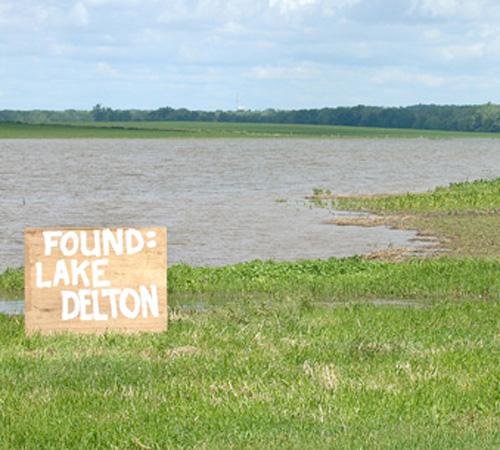Midwest flood waters drive up national crop prices

A homemade sign sits in front of submerged corn crops near U.S. 20 and South Springfield Road near Freeport, Ill. Monday. Heavy flooding in the Midwest has raised the price of crops, especially corn. Joe Tamborello The Journal-Standard for The Associated Press
June 20, 2008
The devastating floods in western and southern Illinois will, in all likelihood, not cause any water-related damages in Champaign. However, the economic effects will be felt in the area, and likely the country, as the price of crops, especially corn, continue to increase.
Iowa and Illinois, two of the country’s largest corn producers, are being hit by flood damage stemming from levee breaches and breaks along the Illinois-Mississippi River interchange. As of Thursday, the Illinois Farm Bureau said that anywhere from 40 to 50,000 of the 23 million fertile acres in Illinois are completely submerged.
“You’re looking at the 40 to 50,000 acre number right now, which is admittedly a small percentage of our acreage,” Illinois Farm Bureau News Service Director John Hawkins said. “But, if any more of these levees break, which it’s looking like they may, that number would jump substantially.”
Prices for June/July delivery of corn are already at $7.08 a bushel in north-central Illinois, which is more than double last September’s prices of approximately $3, according to the University’s College of ACES.
The wide variety of things affected will go beyond just sweet corn. The price of animal feed, used to fatten stock, will increase as the water advances, causing a rise in the price of meat. Another less likely considered product might be soda or anything that contains high-fructose corn syrup, a sweetener. And ethanol gasoline, already surging, may face an increase as well.
Get The Daily Illini in your inbox!
“You’re going to see a lot of products affected that a lot of people don’t think about,” said Kevin Johnson, agricultural liaison to Rep. Timothy Johnson, R-Ill. “It’s pretty late in the game now to be reseeding those crops too – if the land even dries up to make that a viable option.”
While reseeding may be a possibility for some crops that are less water damaged, Hawkins said while he felt for those that are submerged, there is little to no recourse.
“It takes so many days to plant and ready the corn, we’re fast approaching the point of no return, with only about five to six more days to replant,” he said.
There may be some relief in sight for farmers however, with the U.S. Department of Agriculture farm bill possibly providing some assistance.
“We’re talking about the emergency parts of the Farm Bill, if we can use it,” Johnson said. “We might be able to tap into that.”
While the numbers on the total amount of acres damaged is still in the early stages of being reported, there will undoubtedly be more damaged done, both Hawkins and Johnson said. There is still a matter of surveying the total amount of damage done, which will take some time.
“We’re going to be in a holding pattern around here for a while; you can’t really determine too much of the damage right now, clearly,” Johnson said. “If there are problems with reseeding and pollination of more crops, I would expect prices to keep rising.”






